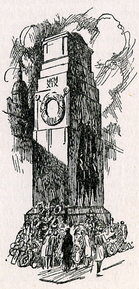 Glastonbury Tor in December snow
Glastonbury Tor in December snow
I would like to wish all members of the HV Morton Society and all readers of the HV Morton blog all the best for the festive season – have a Happy Christmas and a very Good New-Year.
This year I have chosen a section, kindly suggested by a fellow Mortonite, from HVM’s 1933 “A London year” (which was a revision of his original 1926 “The London Year” – note the subtly different title). It is among the best of Morton’s prose, a touching depiction of Christmas day, with suggestions of the hard times which had befallen London and the rest of the world between the writing of the two editions. There is also a clue to what made Morton different from others of his calling and how he achieved his intimate style and popularity – namely his knack of always looking for the humanity in any story.
Christmas Day in London
by HV Morton
A hush more peculiar, more significant and deeper than any hush of the year, falls over London. But it is merely a superficial hush. Actually it is one of the noisiest days in the whole year. Early in the morning the rigid and apparently silent streets are loud with the blowing of tin trumpets, the hooting of toy horns, the beating of kettle-drums, the winding of springs and the explosion of crackers. To the homeless wanderer, however, to whom all hearts turn on this day, London must appear to be wrapped in a self-contained silence. Self-contained it certainly is, for this is the only day in the year on which London has no public life.
The big hotels, in order to keep their doors open, must transform themselves into children’s parties and reproduce on an embarrassing and expensive scale the atmosphere that exists so simply and so beautifully in millions of little homes. Sometimes young reporters, torn from the bosoms of their families, are sent out on a cold unhappy tour of London on Christmas Day. And they all tell the same story. Bald old men, who ought to know better, are wearing paper caps in the Ritz. The Chelsea Pensioners are eating plum pudding. Patients in hospitals lie in garlanded wards. The homeless are herded in an atmosphere which is described as ‘jolly’. That is all that we have ever been able to extract from the most earnest and willing of explorers.
But I can never understand why the earnest young reporter takes the trouble to explore London in search of Christmas. He would do far better if he just stood outside the nearest house and described the lit interior seen through a gap in the curtains: the holly, the mistletoe, the bright children’s faces, the older faces on which Christmas has painted a brief, exceptional carelessness.
It is a day that never changes. It is the one day in the whole year in which London, splitting up into millions of self-contained family groups, is at peace with itself.
[A LONDON YEAR (1933) §4 pp 207-209]
With best wishes once again for a Merry Christmas and a happy and healthy New Year – Slainte Mhor!
Niall Taylor, Glastonbury, Somerset, England






